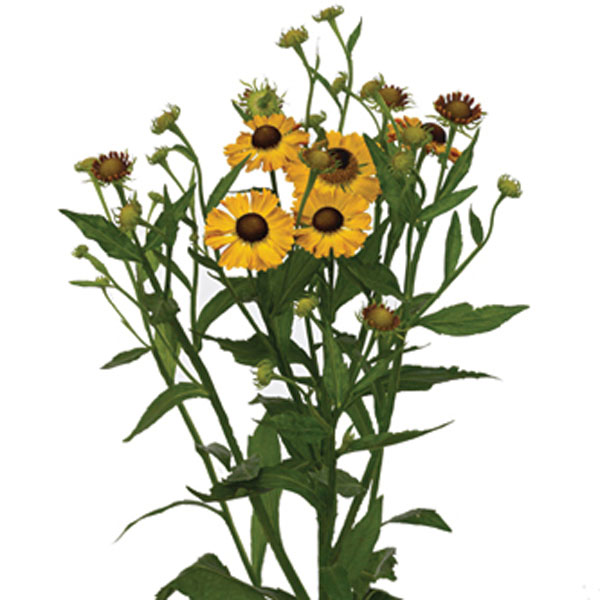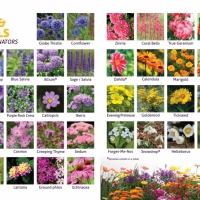Helenium, Sneezeweed (Helenium species)
Features
Helenium are long-lasting cut flowers that make a great filler. Just a few stems can add lush fullness to bouquets. The warm color tones are especially attractive for autumn arrangements. Hard to believe that Helenium flowers are said to symbolize “tears” because the flowers are very bright and cheerful!
Uses
A versatile flower that looks just as good in very formal, elegant arrangements as it does in an old-fashioned garden-style bouquet. A great choice to add fullness and color to an arrangement.
Plant Feed
Mix commercial flower preservative with the vase water.
Watering
Change water every two days.
Planting Instructions
It’s best to keep bouquets out of excessive heat. Direct sunlight, heat vents, radiators, and locations near ovens or fireplaces can cause drying, wilting, or premature death if the temperature gets hot enough.
Cut flowers should not be placed near whole, fresh fruit for long periods of time. Fruits naturally produce ethylene gas as a byproduct of the ripening process. Exposure to this gas can shorten the life of cut flowers.
Be cautious about using any type of flower foods in metal containers or lead crystal vases. The chemicals could react with the metals. This won’t harm the flowers but it could discolor the vase.
Traditional vases aren’t the only way to display a cut bouquet. Be creative when selecting a container for cut flowers. Many everyday containers make interesting “vases” for flowers. As long as it holds water, it may have potential.
No matter what the container, very small flowers often look best in short vases and taller stemmed flowers may require a tall, heavier vase. Often tall stems can simply be cut to accommodate the size of a vase as long as the overall balance and proportion look appealing.
Start by putting the largest flowers in the vase first. Determine the overall height and trim the stems to the desired length.
Trim the remaining flowers to a length that will fill out the area around and below the tallest and largest flowers.
A good rule of thumb is make sure the flower stems are no more than 2/3 the height of the vase. Visually this looks most balanced and in practical terms will keep the bouquet from being top-heavy and possibly tipping over.
Some flowers produce a lot of pollen. To prevent pollen being released simply remove the yellow, pollen-bearing anthers. They are easy to identify because you can see the powdery pollen covering them. Use a tissue or paper towel and gently pluck the anther off. Avoid getting pollen on fingers or clothing since it can stain.
Watering Instructions
Always start with a clean vase. Residue from previous flowers may encourage bacterial growth that could shorten the life of a fresh bouquet. Clean vase with standard dish soap and water.
Fill the vase with enough water to insure that the base of each flower stem is submerged.
Check the water level daily. The flowers will take up a lot of the water but some will evaporate as well. In general a vase should be filled half to two-thirds of the way to the top. By not filling the vase to the top with water, more of the foliage can be preserved. Some leaves are important to maintain the vascular functions of the flowers and will help them stay beautiful and last longer.
Pour out and completely refresh the water every two days. Don’t just top off the water as this won’t remove bacteria that might be building up. Be sure to add commercial plant nutrients to the fresh water to extend the life of the blooms. Packets of flower preservative powder are often provided with bouquets. Mix the powder with the vase water according to the packet directions.
If water appears excessively cloudy or has an unpleasant odor, it needs to be poured out and refreshed no matter how much time has passed. This is an indication that the water is getting stale.
Tap water may contain chemicals that can affect certain flowers. Fluoride, chlorine, sodium from softened water, and minerals in “hard” water can be harmful to some cut flowers or interfere with the stems ability to take up water properly. If water quality is an issue some options include: A pitcher of water can be left to stand for 24 hours to allow chlorine to evaporate. Filtered water should be free of most chemicals. Collecting rainwater is popular for outdoor gardening and is perfecting suitable for cut flowers, as long as the collection receptacle is free from debris and the water is clean.
Fertilizing Instructions
It is very common for pre-packaged bouquets and arrangements from the florist to come with a packet of commercial flower preservative. A lot of research has gone into developing the perfect blend of nutrition, bacterial inhibitors, and pH adjusters for the water. Using these products can significantly extend the beauty and life of cut flowers. Be sure to follow the package directions when mixing.
There are a number of home recipes that are popular for extending the life of flowers and it’s easy to research different options. Given that the experts have already figured out the ideal balance, it’s easiest to go with commercially available products. Keep in mind that some of the home recipes, particularly those that include sugar or sugar-based drinks as an energy source, may also be an invitation to pests. These can also trigger additional bacterial growth if too much is put in the water.
Pruning Instructions
Fluids constantly circulate through a growing plant. Once flower stems are cut off, the stems continue trying to draw up fluids. During the time that stems are cut from a plant, or removed from the water at the florist for the journey home (or to surprise a friend or loved one), there is time for the flowers to draw air into the stems. This bit of air is enough to prevent good fluid movement once the stems are replaced in water at their destination. This is why it is important to give each stem a fresh cut when putting them in a vase.
Use a sharp scissors or clippers designed for cut flowers. Dull cutting tools can crush the stems and destroy the cells that are essential for drawing up water.
Always cut the stem on a slant. This exposes more stem surface area for water uptake. Place the cut stem into water immediately after cutting.
Remove all leaves that will fall below the water line. If left on the stem these will simply decay and encourage bacterial growth that can plug the vascular system of the stem. If that happens the life of the flower will be reduced because the blooms can’t get good hydration.
It’s best to trim away foliage with a sharp knife or scissors. Tearing off leaves can cause unnecessary wounding where bacteria can enter.
Trim away or remove from the vase any wilted flowers. These diminish the fresh look of the flowers and will continue to decline, decay, and lead to bacterial growth in the water.
Plant Details
| Available Colors: | Gold, Red, Orange, and Bicolor |
| Bloom Time: | 4-12 days |
| Temperature Range: | 65° to 75°F (18° to 24°C) |
| Plant Light: | Medium Light |
| Companion Plants: | Celosia, Sunflower, Rose Hips |
Availability
- Jan
- Feb
- Mar
- Apr
- May
- Jun
- Jul
- Aug
- Sep
- Oct
- Nov
- Dec



